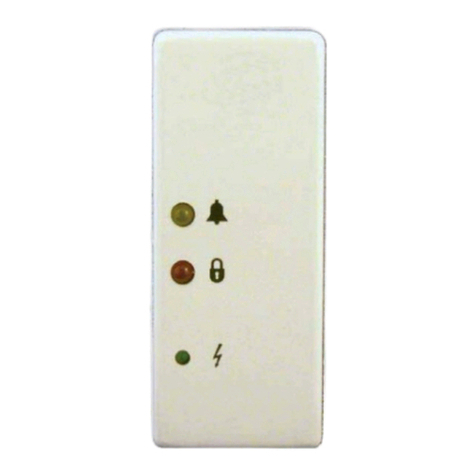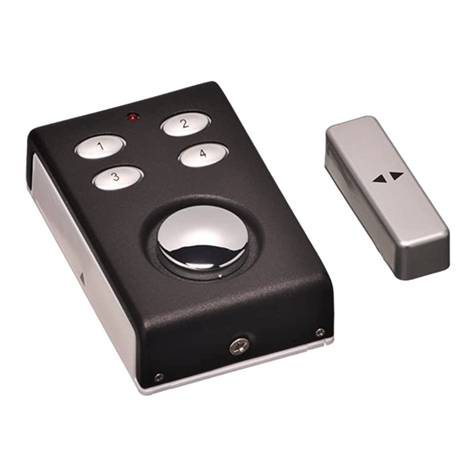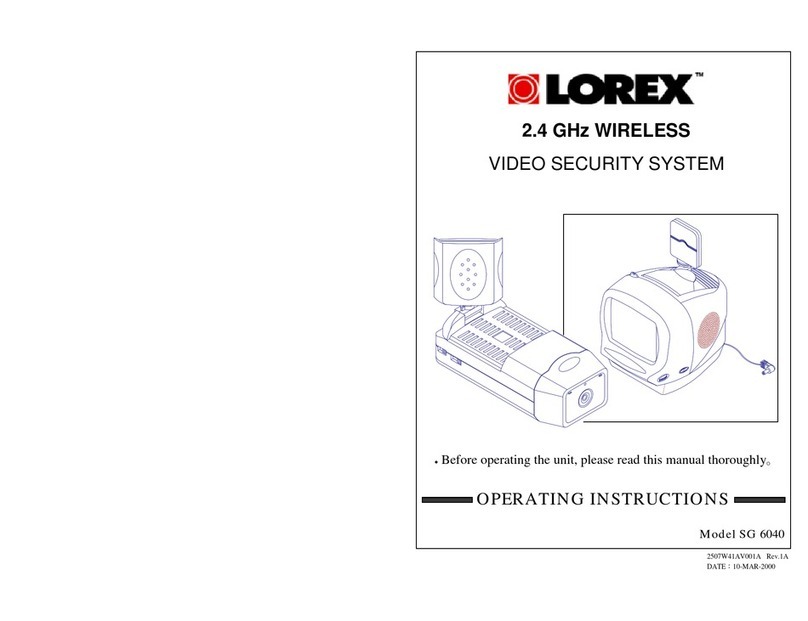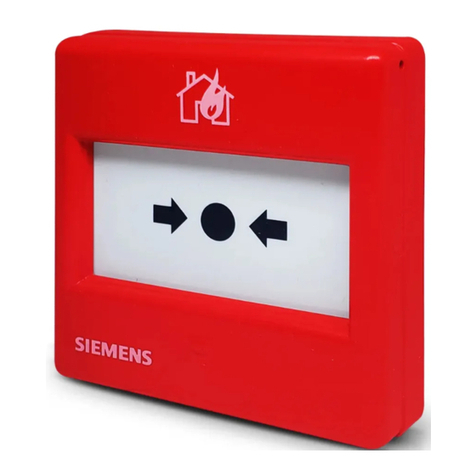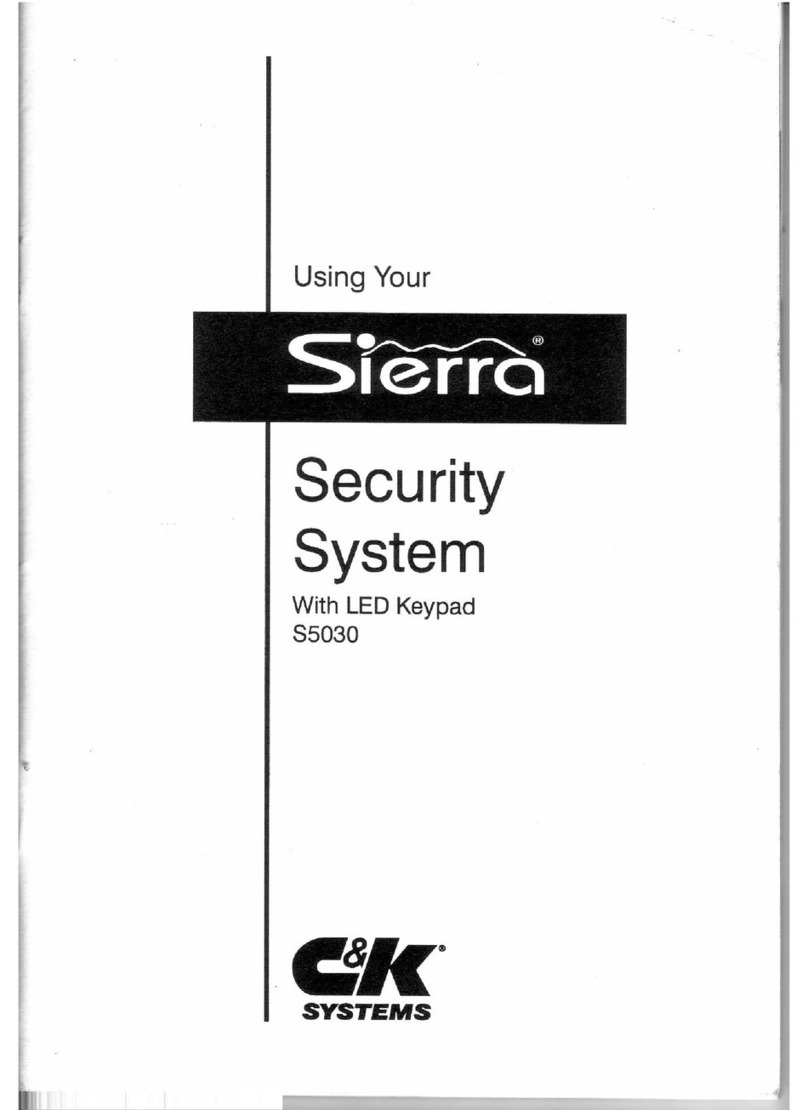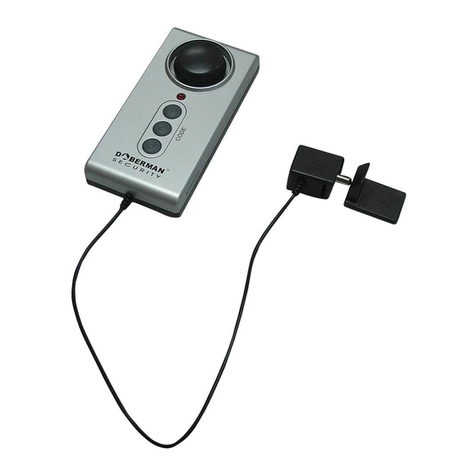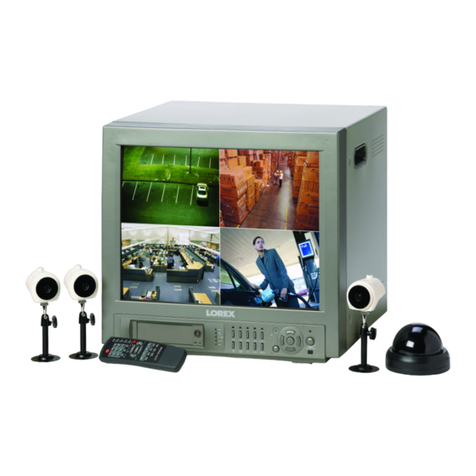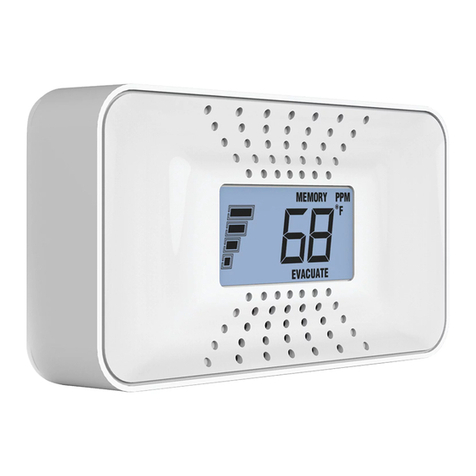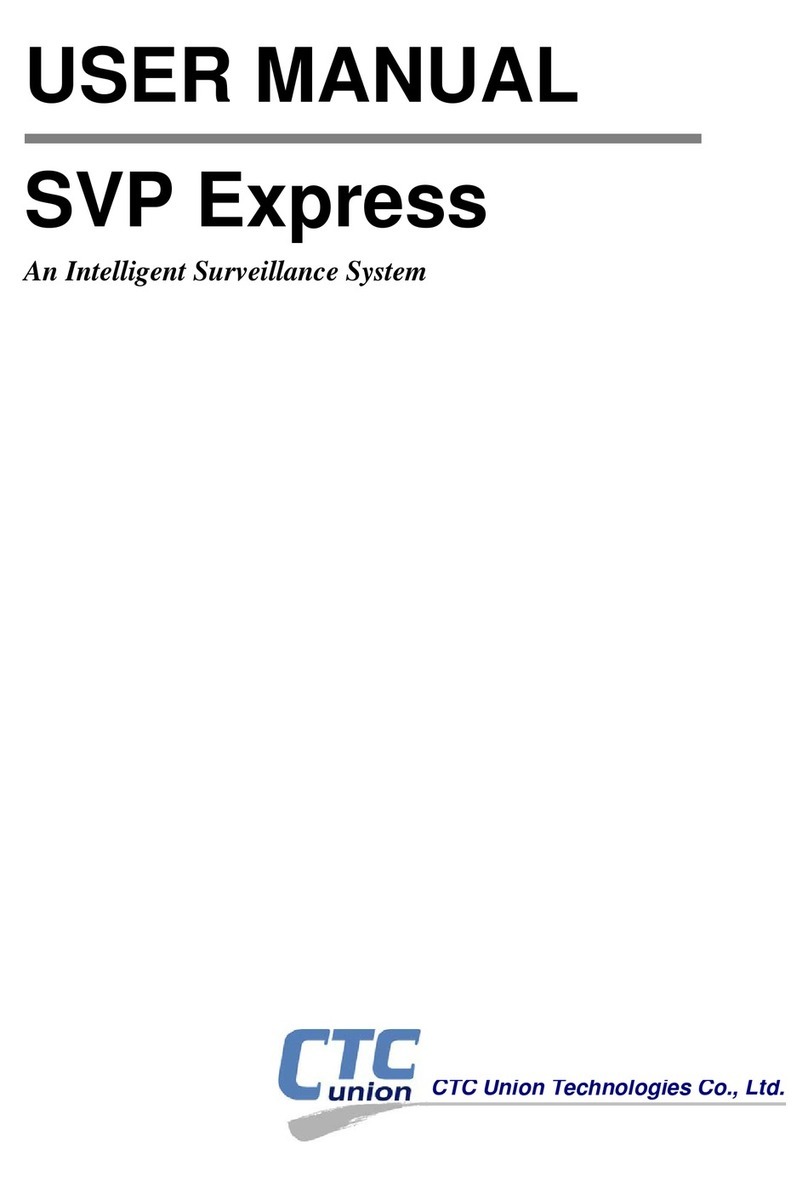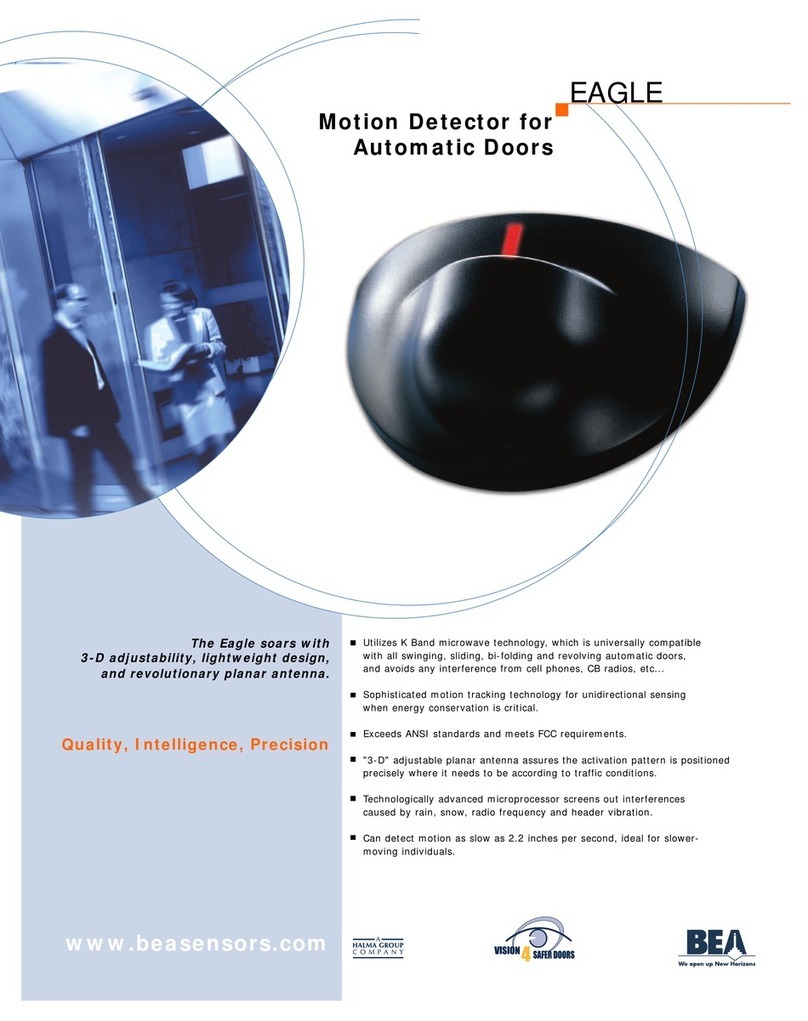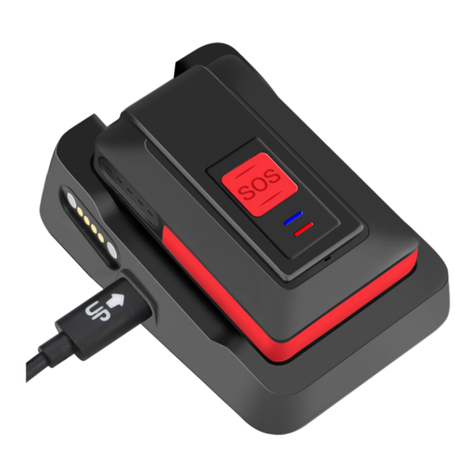Ness SmartLiving 505 Assembly instructions

2
Anti-intrusion control panels
Warranty
Ness Corporation (as known as Ness in this document) warrants the original
purchaser that this product shall be free from defects in materials and
workmanship under normal use for a period of 24 months. As Ness does not
install this product directly, and due to the possibility that it may be used with
other equipment not approved by Us; Ness does not warrant against loss of
quality, degradation of performance of this product or actual damage that results
from the use of products, parts or other replaceable items (such as consumables)
that are neither made nor recommended by Ness. Seller obligation and liability
under this warranty is expressly limited to repairing or replacing, at Seller's
option, any product not meeting the specifications. In no event shall Ness be
liable to the purchaser or any other person for any loss or damage whether direct
ot indirect or consequential or incidental, including without limitation, any
damages for lost profits, stolen goods, or claims by any other party caused by
defective products or otherwise arising from the incorrect or otherwise improper
installation or use of this product.
This warranty applies only to defects in parts and workmanship relating to normal
use. It does not cover:
• damage arising from improper maintenance or negligence
• damage caused by fire, flood, wind or lightning
• vandalism
• fair wear and tear
Ness shall, at its discretion, repair or replace any defective products. Improper
use, that is, use for purposes other than those mentioned in this manual will void
the warranty. Contact Our authorized dealer, or visit our website for further
information regarding this warranty.
Limited
warranty
Ness shall not be liable to the purchaser or any other person for damage arising
from improper storage, handling or use of this product.
Installation of this Product must be carried out by qualified persons appointed by
Ness. Installation of this Product must be carried out in accordance with Our
instructions in the product manual.
Copyright
The information contained in this document is the sole property of Ness. No part
may be copied without written authorization from Ness.
All rights reserved.
Directive
compliance
Hereby Ness declares that the SmartLiving series of intrusion-control panels, the
Air2 series of devices and the SecureLink / SmartLink product are in compliance
with the essential requirements and other relevant provisions of Directive 1999/
5/CE.
Moreover, Ness also declares that all other devices mentioned in this manual are
in compliance with the essential requirements and other relevant provisions of
Directive 2004/108/CE.
The full declarations of conformity can be found at URL:
www.nesscorporation.com.
State-of-the-art
installations
(DM 37/08)
The devices described in this manual, in accordance with the settings selected
during the installation phase and the following illustrated guidelines are,
alternatively, in compliance with the the Italian Normative CEI 79-
2:1998+Ab:2000 performance level 2 or European Normative CEI EN 50131-
3:2009 (in reference to Control and indicating equipment - intrusion control
panels) and CEI EN 50131-6:2008 (in reference to Power supplies) security grade
2.
In support of research, development, installation, testing, commissioning and
maintenance of intrusion alarm systems installed in buildings please refer to the
following normative documents:
CEI 79-3 e CEI CLC/TS 50131-7.
When installing Ness products, it is up to the installation company to install
systems equipped with Normative CEI 79-2 compliant devices rather than devices
compliant with European Normatives series EN50131 within and not over the
DOWs summarized in amendment CEI 79-2;V1:2010.
2
Anti-intrusion control panels
Warranty
Ness Corporation (as known as Ness in this document) warrants the original
purchaser that this product shall be free from defects in materials and
workmanship under normal use for a period of 24 months. As Ness does not
install this product directly, and due to the possibility that it may be used with
other equipment not approved by Us; Ness does not warrant against loss of
quality, degradation of performance of this product or actual damage that results
from the use of products, parts or other replaceable items (such as consumables)
that are neither made nor recommended by Ness. Seller obligation and liability
under this warranty is expressly limited to repairing or replacing, at Seller's
option, any product not meeting the specifications. In no event shall Ness be
liable to the purchaser or any other person for any loss or damage whether direct
ot indirect or consequential or incidental, including without limitation, any
damages for lost profits, stolen goods, or claims by any other party caused by
defective products or otherwise arising from the incorrect or otherwise improper
installation or use of this product.
This warranty applies only to defects in parts and workmanship relating to normal
use. It does not cover:
• damage arising from improper maintenance or negligence
• damage caused by fire, flood, wind or lightning
• vandalism
• fair wear and tear
Ness shall, at its discretion, repair or replace any defective products. Improper
use, that is, use for purposes other than those mentioned in this manual will void
the warranty. Contact Our authorized dealer, or visit our website for further
information regarding this warranty.
Limited
warranty
Ness shall not be liable to the purchaser or any other person for damage arising
from improper storage, handling or use of this product.
Installation of this Product must be carried out by qualified persons appointed by
Ness. Installation of this Product must be carried out in accordance with Our
instructions in the product manual.
Copyright
The information contained in this document is the sole property of Ness. No part
may be copied without written authorization from Ness.
All rights reserved.
Directive
compliance
Hereby Ness declares that the SmartLiving series of intrusion-control panels, the
Air2 series of devices and the SecureLink / SmartLink product are in compliance
with the essential requirements and other relevant provisions of Directive 1999/
5/CE.
Moreover, Ness also declares that all other devices mentioned in this manual are
in compliance with the essential requirements and other relevant provisions of
Directive 2004/108/CE.
The full declarations of conformity can be found at URL:
www.nesscorporation.com.
State-of-the-art
installations
(DM 37/08)
The devices described in this manual, in accordance with the settings selected
during the installation phase and the following illustrated guidelines are,
alternatively, in compliance with the the Italian Normative CEI 79-
2:1998+Ab:2000 performance level 2 or European Normative CEI EN 50131-
3:2009 (in reference to Control and indicating equipment - intrusion control
panels) and CEI EN 50131-6:2008 (in reference to Power supplies) security grade
2.
In support of research, development, installation, testing, commissioning and
maintenance of intrusion alarm systems installed in buildings please refer to the
following normative documents:
CEI 79-3 e CEI CLC/TS 50131-7.
When installing Ness products, it is up to the installation company to install
systems equipped with Normative CEI 79-2 compliant devices rather than devices
compliant with European Normatives series EN50131 within and not over the
DOWs summarized in amendment CEI 79-2;V1:2010.
Ness Smartliving
Installation and Programming Manual
Document Part No: 890-443
All rights reserved. No part of this publication may be reproduced, transmitted or stored in a retrieval system in any form or by any
means, electronic, mechanical, photocopying, recording, or otherwise, without the prior written permission of Ness.
Ness reserves the right to make changes to features and specications at any time without prior notication in the interest of ongoing
product development and improvement.
© 2014 Ness Corporation Pty Ltd ABN 28 069 984 372
www.nesscorporation.com
National Customer Service Centre
Ph: 1300 551 991
CEI 79-2
EN 50131-3
EN 50131-6
CEB T01

Installation and programming manual
3
Table of
contents
Warranty . . . . . . . . . . . . . . . . . . . . . . . . . . . . . . . . . . . . . . . 2
Limited warranty . . . . . . . . . . . . . . . . . . . . . . . . . . . . . . . . . 2
Copyright . . . . . . . . . . . . . . . . . . . . . . . . . . . . . . . . . . . . . . 2
European Directive compliance. . . . . . . . . . . . . . . . . . . . . . . . 2
State-of-the-art installations (DM 37/08) . . . . . . . . . . . . . . . . 2
Table of contents . . . . . . . . . . . . . . . . . . . . . . . . . . . . . . . . . 3
About this manual . . . . . . . . . . . . . . . . . . . . . . . . . . . . . . 5
0-1 Terminology . . . . . . . . . . . . . . . . . . . . . . . . . . . . . . . . . . . . . . . . . 5
0-2 Graphic conventions. . . . . . . . . . . . . . . . . . . . . . . . . . . . . . . . . . . . 5
Chapter 1 General information . . . . . . . . . . . . . . . . . . . . . . . . . . . . . 6
1-1 Manufacturer's details . . . . . . . . . . . . . . . . . . . . . . . . . . . . . . . . . . 6
1-2 Description of the product and various models . . . . . . . . . . . . . . . . . 6
1-3 Products certified and conforming to directives . . . . . . . . . . . . . . . . . 6
1-4 Patents Pending. . . . . . . . . . . . . . . . . . . . . . . . . . . . . . . . . . . . . . . 7
1-5 Manuals . . . . . . . . . . . . . . . . . . . . . . . . . . . . . . . . . . . . . . . . . . . . 7
1-6 Operator Qualifications . . . . . . . . . . . . . . . . . . . . . . . . . . . . . . . . . . 8
1-7 Access Levels . . . . . . . . . . . . . . . . . . . . . . . . . . . . . . . . . . . . . . . . 8
1-8 Conventions – Glossary . . . . . . . . . . . . . . . . . . . . . . . . . . . . . . . . . 8
Chapter 2 The control panel and peripherals . . . . . . . . . . . . . . . . . . . 9
2-1 Environmental Conditions . . . . . . . . . . . . . . . . . . . . . . . . . . . . . . . . 9
2-2 SmartLiving intrusion control panels . . . . . . . . . . . . . . . . . . . . . . . . 9
2-3 Peripherals . . . . . . . . . . . . . . . . . . . . . . . . . . . . . . . . . . . . . . . . . . 13
2-4 SmartLAN ethernet interface. . . . . . . . . . . . . . . . . . . . . . . . . . . . . . 21
2-5 AUXREL32 power distribution board . . . . . . . . . . . . . . . . . . . . . . . . . 22
Chapter 3 Installation . . . . . . . . . . . . . . . . . . . . . . . . . . . . . . . . . . . 23
3-1 Installing the control panel . . . . . . . . . . . . . . . . . . . . . . . . . . . . . . . 23
3-2 Connecting peripherals. . . . . . . . . . . . . . . . . . . . . . . . . . . . . . . . . . 29
3-3 Addressing the peripherals . . . . . . . . . . . . . . . . . . . . . . . . . . . . . . . 34
3-4 Auto-enrolling peripherals. . . . . . . . . . . . . . . . . . . . . . . . . . . . . . . . 36
3-5 Wiring and balancing alarm detectors. . . . . . . . . . . . . . . . . . . . . . . . 37
3-6 Wiring and balancing rollerblind/shock sensors . . . . . . . . . . . . . . . . . 39
3-7 Connecting wireless detectors . . . . . . . . . . . . . . . . . . . . . . . . . . . . . 40
3-8 Learn zone balancing . . . . . . . . . . . . . . . . . . . . . . . . . . . . . . . . . . . 40
3-9 Connecting the outputs . . . . . . . . . . . . . . . . . . . . . . . . . . . . . . . . . 40
3-10 Installing add-on boards . . . . . . . . . . . . . . . . . . . . . . . . . . . . . . . . . 41
3-11 IP and Internet Connectivity . . . . . . . . . . . . . . . . . . . . . . . . . . . . . . 43
Chapter 4 First power up . . . . . . . . . . . . . . . . . . . . . . . . . . . . . . . . . 45
Chapter 5 Installation project via the SmartLeague . . . . . . . . . . . . . . 46
5-1 The SmartLeague software programme . . . . . . . . . . . . . . . . . . . . . . 46
5-2 Using the software programme . . . . . . . . . . . . . . . . . . . . . . . . . . . . 47
5-3 Creating a project layout . . . . . . . . . . . . . . . . . . . . . . . . . . . . . . . . 47
Chapter 6 Options and programming methods . . . . . . . . . . . . . . . . . . 49
6-1 Introduction . . . . . . . . . . . . . . . . . . . . . . . . . . . . . . . . . . . . . . . . . 49

4
Anti-intrusion control panels
6-3 Programming via the SmartLeague programme . . . . . . . . . . . . . . . . 50
6-4 Fast programming from the keypad (Wizard) . . . . . . . . . . . . . . . . . . 50
6-5 Panel options . . . . . . . . . . . . . . . . . . . . . . . . . . . . . . . . . . . . . . . . 51
6-6 Terminals . . . . . . . . . . . . . . . . . . . . . . . . . . . . . . . . . . . . . . . . . . . 54
6-7 Zones . . . . . . . . . . . . . . . . . . . . . . . . . . . . . . . . . . . . . . . . . . . . . 56
6-8 Outputs . . . . . . . . . . . . . . . . . . . . . . . . . . . . . . . . . . . . . . . . . . . . 60
6-9 Walk test . . . . . . . . . . . . . . . . . . . . . . . . . . . . . . . . . . . . . . . . . . . 61
6-10 Telephone . . . . . . . . . . . . . . . . . . . . . . . . . . . . . . . . . . . . . . . . . . 62
6-11 Events . . . . . . . . . . . . . . . . . . . . . . . . . . . . . . . . . . . . . . . . . . . . . 63
6-12 Timer. . . . . . . . . . . . . . . . . . . . . . . . . . . . . . . . . . . . . . . . . . . . . . 71
6-13 Partitions . . . . . . . . . . . . . . . . . . . . . . . . . . . . . . . . . . . . . . . . . . . 72
6-14 User Codes . . . . . . . . . . . . . . . . . . . . . . . . . . . . . . . . . . . . . . . . . . 73
6-15 Installer codes . . . . . . . . . . . . . . . . . . . . . . . . . . . . . . . . . . . . . . . 75
6-16 Keys . . . . . . . . . . . . . . . . . . . . . . . . . . . . . . . . . . . . . . . . . . . . . . 76
6-17 Arming scenarios. . . . . . . . . . . . . . . . . . . . . . . . . . . . . . . . . . . . . . 77
6-18 Shortcuts . . . . . . . . . . . . . . . . . . . . . . . . . . . . . . . . . . . . . . . . . . . 78
6-19 Expansions . . . . . . . . . . . . . . . . . . . . . . . . . . . . . . . . . . . . . . . . . . 79
6-20 Keypads . . . . . . . . . . . . . . . . . . . . . . . . . . . . . . . . . . . . . . . . . . . . 79
6-21 Readers . . . . . . . . . . . . . . . . . . . . . . . . . . . . . . . . . . . . . . . . . . . . 80
6-22 Sounders . . . . . . . . . . . . . . . . . . . . . . . . . . . . . . . . . . . . . . . . . . . 81
6-23 Language . . . . . . . . . . . . . . . . . . . . . . . . . . . . . . . . . . . . . . . . . . . 81
6-24 Messages . . . . . . . . . . . . . . . . . . . . . . . . . . . . . . . . . . . . . . . . . . . 82
6-25 Default settings. . . . . . . . . . . . . . . . . . . . . . . . . . . . . . . . . . . . . . . 82
6-26 User functions. . . . . . . . . . . . . . . . . . . . . . . . . . . . . . . . . . . . . . . . 84
6-27 Other parameters . . . . . . . . . . . . . . . . . . . . . . . . . . . . . . . . . . . . . 85
6-28 Activating outputs without authentication. . . . . . . . . . . . . . . . . . . . . 88
6-29 Programming the Nexus . . . . . . . . . . . . . . . . . . . . . . . . . . . . . . . . . 89
Chapter 7 Complacency with the regulations in force . . . . . . . . . . . . . 92
Chapter 8 Errors and faults . . . . . . . . . . . . . . . . . . . . . . . . . . . . . . . 95
8-1 Faults detected by the control panel . . . . . . . . . . . . . . . . . . . . . . . . 95
8-2 Communication BUS (I-BUS) . . . . . . . . . . . . . . . . . . . . . . . . . . . . . 96
8-3 LED activity . . . . . . . . . . . . . . . . . . . . . . . . . . . . . . . . . . . . . . . . . 96
8-4 Ring Sensitivity . . . . . . . . . . . . . . . . . . . . . . . . . . . . . . . . . . . . . . . 97
8-5 Calibrating the touch-screen . . . . . . . . . . . . . . . . . . . . . . . . . . . . . . 97
Appendix A Technical terminology and Glossary. . . . . . . . . . . . . . . . . . 98
Appendix B Shortcuts at default . . . . . . . . . . . . . . . . . . . . . . . . . . . . . 106
Appendix C Available Icons . . . . . . . . . . . . . . . . . . . . . . . . . . . . . . . . 107
Appendix D Voice messages. . . . . . . . . . . . . . . . . . . . . . . . . . . . . . . . 108
Appendix E Screw Terminals . . . . . . . . . . . . . . . . . . . . . . . . . . . . . . . 110
Appendix F Combination of outputs triggered by events . . . . . . . . . . . . 111
Appendix G SIA Codes . . . . . . . . . . . . . . . . . . . . . . . . . . . . . . . . . . . 112

Installation and programming manual
About this manual 5
ABOUT THIS MANUAL
MANUAL CODE
DCMIINE0SLIVINGE
VERSION
5.10
0-1Terminology
CONTROL PANEL,
S STEM, DEVICE
he main supervisory unit or any constituent parts of the SmartLiving intrusion control
system.
LEFT, RIGHT, BEHIND,
ABOVE, BELOW
Directions as seen by the operator when directly in front of the mounted device.
DIALER
A device which sends voice calls or digital reports to programmed contact numbers in
the event of an alarm.
QUALIFIED PERSONNEL
Persons whose training, expertise and knowledge of the products and laws regarding
security systems, are able to create, in accordance with the requirements of the
purchaser, the most suitable solution for the protected premises.
SELECT
Click on a specific item on the interface (drop-down menu, options box, graphic object,
etc.).
PRESS
Click on a video button, or push a key on the control-panel keypad.
0-2Graphic conventions
Following are the graphic conventions used in this manual.
Note
he “Note” sections contain important information relating to the text.
ATTENTION!
The “Attention” prompts indicate that total or partial disregard of the procedure could
damage the device or its peripherals.
DANGER!
The “DANGER” warnings indicate that total or partial disregard of the procedure could
injure the operator or persons in the vicinity.
Similarly marked dialogue boxes contain recommendations and/or guidelines which the
manufacturer wishes to call attention to.
Conventions Example Description
ext in italics See paragraph 0-2 Graphic
conventions
Indicates the title of a chapter, section, para-
graph, table or figure in this manual or other
published reference.
<text> #<AccountCode> Editable field
[Uppercase letter] or [num-
ber] [A] or [1] Reference relating to a part of the system or
video object.
BU ON , , Keypad keys
Info

6 General information
Chapter 1
GENERAL INFORMATION
1-1Supplier's details
Supplier: Ness Corporation
Address: 4/167 Prospect Hwy,
Seven Hills, NSW, 2147 Australia
el: +61 2 8825 9222
e-mail: customerservice@ness.com.au
Web: www.nesscorporation.com
he persons authorized by the manufacturer to repair or replace the parts of this
system, hold authorization to work on Ness Corporation’s brand devices only.
1-2Description of the product and
various models
Description: Intrusion control panel
Models: SmartLiving 505
SmartLiving 515
SmartLiving 1050
SmartLiving 10100
Applied Normative: CEI 79-2:1998+Ab:2000, CEI EN 50131-3:2009 and CEI EN
50131-6:2008
Certification agency: IMQ - Security systems
Security rating: 2
1-3Products certified and
conforming to directives
he SmartLiving intrusion control panel and the devices described in this manual have
been certified by the IMQ - Security Systems agency as compliant with CEI 79-
2:1998+Ab:2000, CEI EN 50131-3:2009 and CEI EN 50131-6:2008, when duly
programmed, as described in Chapter 7 - Compliancy with the regulations in force.
he Control panel enclosure houses the following certified devices:
• INIM switching-power supply
• Motherboard (IN082 or IN088)
• SmartLogos30M voice board (accessory item)
• FLEX5/U input/output expansion board (accessory item)
• AUXREL32 relay board (accessory item)
• SmartLAN/SI and SmartLAN/G LAN interface boards (accessory items)
• IB100/RU BUS isolator board (accessory item)
• Probe H thermal-probe kit for battery-charge optimization (accessory item)
• amperNO tamper-protection kit (accessory item)
• Backup battery, 12 V @ 17 Ah
• Motherboard (IN082 and IN088) integrated ype B notification apparatus
he control panel complacency is also guaranteed when connected to the following
certified devices:

Installation and programming manual
General information 7
• FLEX5/P input/output expansion boards
• Joy/MAX, Joy/GR, cCode/G, nCode/G keypads
• nBy/S outdoor-mount proximity readers
• nBy/X universal-mount proximity readers
• IB100/RP BUS isolator
• Self-powered IB100/A BUS isolator
• nCard access-control card for proximity readers
• ag for nKey or nBoss proximity readers
• Self-powered sounderflashers for outdoor installation: Ivy, Ivy-F, Ivy-M, Ivy-FM, Ivy-
B, Ivy-BF, Ivy-BM, Ivy-BFM
• Wireless devices AIR2, AIR2-BS100 (transceivers), Air2-IR100 (PIR detectors), Air2-
MC100 (magnetic contacts)
T PE B NOTIFICATION
APPARATUS
A S2 notification apparatus (refer to EN50131-1:2008-02, paragraph 8.6 Notification,
able 10, page 46, Grade 2 and EN50136) characterized by:
• ransmission time - classification D2 (60 seconds)
• ransmission time - max. values M2 (120 seconds)
• Classification time - classification 2 (25 hours)
• S0 Substitution security (no detection of device substitution)
• I0 Information security (no detection of message substitution)
A S4 notification apparatus (refer to EN50131-1:2008-02, paragraph 8.6 Notification,
able 10, page 46, Grade 3 and EN50136) features the following parameters (available
on SmartLAN/G and SmartLAN/SI only):
• ransmission time - classification D2 (60 seconds)
• ransmission time - max. values M2 (120 seconds)
• Classification time - classification 3 (300 minutes)
• S1 Substitution security (measures aimed at detecting the substitution of the
transceiver of the supervised site by means of an identifier code or address in all
messages sent over the transmission link).
• I2 Information security (measures aimed at impeding unauthorized changes to
transmitted information).
1-4Patents Pending
he SmartLiving series of control panels employs the following patented technologies.
•Input/Output Terminals: each terminal on-board the control panel, keypads and
expansion boards can be configured as either an input or output zone.
•nBy/X proximity reader: this reader has been especially designed to flush-mount
to all models of electrical light-switch backboxes.
•Learn zone balancing: this option allows the control panel to save the balancing
values of all the system zones automatically, thus eliminating the task of typing
them in.
1-5Manuals
1-5-1
Installation and
programming manual
(this manual)
his manual (not included in the package) can be purchased from your retailer. You (the
installer) should read carefully through it in order to become familiar with all the
components and operating procedures of the SmartLiving system.
In order to provide adequate protection, the installer must adhere to all the
manufacturer's guidelines relating to the active and passive security devices of this
system.
1-5-2
Installation and
programming guide
his guide is included in the control panel package and provides all the instructions and
illustrations necessary for fast installation and programming of the SmartLiving system.
It provides step by step descriptions of the procedures required for the system wiring,

8 General information
the various connections and first power-up. It also provides a table for the peripheral
addressing process and a quick guide indicating default parameters and values and how
to programme/change them directly from the keypad.
1-5-3
User's manual
he installer should read carefully through the user's manual (supplied with each
control panel). Once the system has been installed, you must ensure that the User's
Manual is available to the users for consultation, and that they fully understand how the
system works and are aware of all the functions, settings and procedures.
It is the installer's responsibility to inform the system users that, regardless of its
capabilities, an intrusion alarm system is not a substitute for the necessary precautions
building occupants must take to prevent intrusion.
1-6Operator Qualifications
1-6-1
Installer
he installer is the person (or group of persons) who sets up and programs the entire
security system in accordance with the purchaser's requirements and in respect of the
safety and security regulation in force. As the only individual in contact with system
users, it is the installer's responsibility to instruct them on how to use the security
system properly.
Under normal circumstances, the installer is not allowed to arm/disarm the system
without previous authorization from the user. All the system partitions must be
disarmed before accessing the parameter programming phase.
he access code of the installer is a level 3 access code.
1-6-2
User
he users are the occupants of the building where this intrusion control panel is
installed. Only authorized users can access and operate the system.
hanks to the extreme flexibility of the system, the most common operations can be
carried out without authorization. his operating method must be expressly requested
by the main user, as it considerably lowers the security level of the system and may
cause false alarms, accidental arm/disarm operations, etc.
A system access code can be associated with each user. he programming process
allows you to define the code hierarchy:
•User
•Manager
•Master
he system codes can carry out, in accordance with their assigned level in the
system hierarchy (the "User" being the lowest level), the following operations on all
other codes that are inferior hierarchically:
•• enable/disable
•• change PIN
•• change the programming parameters
If the system programming complies with security grade 3 of EN 50131, some partition
arming or delete memory operations, requested from a keypad, may be authorized by
the entry of a level 3 code (installer code) as well as by a user code.
1-7Access Levels
he normative defines the following system-access levels, regardless of system-access
limitations:
•Level 1 - access by any person (e.g. passer-by)
•Level 2 - user access
•Level 3 - installer or maintenance operator access (authorized by user - level 2)
•Level 4 - manufacturer access
1-8Conventions – Glossary
In order to understand the terminology used in this manual and improve your
knowledge of this system and its operating procedures, read carefully through the
glossary (refer to Appendix A, Technical terminology and Glossary). he appendix
contains the definitions of technical terms commonly used in the field of security,
therefore, relevant to the SmartLiving system.

Installation and programming manual
he control panel and peripherals 9
Chapter 2
THE CONTROL PANEL
AND PERIPHERALS
2-1Environmental Conditions
All control panels from the SmartLiving series are for indoor installation only and
operate best under the following conditions:
•Temperature: from -10° to +40°C
•Maximum humidity:75% (without condensation)
•Environmental class:II
he nCode/G, cCode/G, Alien/S, Alien/G, IB100, FLEX5, Nexus and nBy/X peripheral
devices are for indoor installation only and operate best under the following
environmental conditions:
•Temperature: from -10° to +40°C
•Maximum humidity:75% (without condensation)
•Environmental class:II
he nBy/S reader is suitable for outdoor installation and operates best under the
following conditions:
•Temperature: from -25° to +70°C
•Maximum humidity:93% (without condensation)
•Protection grade:IP34
•Environmental class:IV
2-2SmartLiving intrusion
control panels
2-2-1
Package contents
Inside the package you will find:
• Metal enclosure containing the wired motherboard and power supply (adapter or
switching-power supply)
• User's Manual
• Quick Installation Guide
• Plastic bag:
Items not included in the package:
hermal probe (battery-charge optimizer which operates in accordance with the battery
temperature), backup battery, Dialler Lead, SmartLeague programme CD, Installation
Manual. hese devices are accessory items which must be purchased separately.
able 1:
Package contents
Control panel models
505 515 1050 1050L 10100L
3k9 Ohm 1/4W resistance
10 20
Resistance 6k8 Ohm 1/4W
10 20
Backup-battery wire
1
Screws to secure the frontplate of
the metal enclosure
4

10 he control panel and peripherals
2-2-2
Control panel descriptions
Compliancy with EN 50131, CEI 79 or CEB 014 requires that the values of the
maximum distributable current respect determined limits, as indicated in paragraph -
1- Maximum current - normative references.
he control panel label s located inside the enclosure.
he following table shows the maximum number of devices supported by the various
control panel models.
Note
SmartLiving control panels are not equipped with built-in dislodgement-tamper microswitches.
For the order code of this accessory item, refer to Ness Sales staff.
able 2:
Control panels - electrical and mechanical features
Control panel models
505 515 1050 1050L 10100L
Power supply voltage
230V
~
-15% +10% 50/60Hz
Nominal output voltage
13.8V
Voltage - operating range
9 - 16 V
Maximum current draw
0.2A 0.4A 0.6A
Current draw of control panel
motherboard
110mA @ 22V
~
75mA @ 13.8V=
Maximum distributable current @ 12V
1.2A 3A 5A
Maximum distributable current to
open-collector outputs
150mA 500mA
Maximum power-supply voltage ripple
340mV 70mV
Max. battery-charge current
1A 2A
Backup battery
12V 7Ah 12V 17Ah
recharged 80% in 24h
Max. current across +AUX terminals
900mA 4.05A
(1.35A for +AUX1, 1.35A for +AUX2, 1.35A for +AUX3)
Power supply (EN 50131)
ype A
Enclosure Dimensions (W x H x D)
21.5 x 30.5 x 8.5cm 37.5 x 51 x 8.5cm
Weight (without battery)
2.5 Kg 2.2 Kg 5.3 Kg
able 3:
Control panel - Main Features
Control panel models
505 515 1050 1050L 10100L
Total terminals
5 15 50 100
Terminals on
panel
total
5 10
configurable as inputs
5 10
configurable as rollerblind/shock
2
configurable as outputs
0 5
Total zones
10 30 100 200
Outputs on
control-panel
motherboard
total
3
Relay
1
open-collector
2
Partitions
5 10 15
Keypads
(JO , nCode/G, cCode/G, Alien)
5 10 15
Voice memo slots
5 10 15
FLEX5 expansions
5 10 20 40
nBy Readers
10 20 30
Air2-BS100 Transceivers
10 20 30
Digital keys and keyfobs
50 100 150
Possible key combinations
4294967296
IB100 isolators
15
Nexus dialer
1
Codes
30 50 100
Scenarios
30
Timer
10 20
Recordable Events
500 1000
Programmable events
10 30 50

Installation and programming manual
he control panel and peripherals 11
able 4:
Control panels - description of parts
Models 505 515 1050 1050L 10100L
A
Power adapter ( ransformer) 3A switching power supply 5A switching
power supply
B
Mains connection terminal-board (230 Vac) - 50/60 Hz
C
Power cable - adapter to control
panel Power cable - switching-power supply to panel
D
Power cable - switching-power supply to panel
E
Mains cable entry
F
Metal enclosure
G
Anchor-screw locations for the metal backbox
H
Dislodgement-tamper microswitch location
I
Backup battery
J
Backup-battery wire
K
Backup-battery connector
L
hermal probe (accessory item)
M
hermal probe connector
N
hermal probe (enable/disable)
jumper
O
Connectors for the SmartLAN power-supply jumper
P
Local I-BUS connector
Q
Maintenance jumper connectors
R
SmartLogos30M voice-board connector
S
Control panel to PC serial cable connector
T
Dislodgement-tamper microswitch connector (accessory item)
U
Open-panel tamper microswitch connector (accessory item)
V
Open-panel tamper microswitch
W
erminal board
X
Blue and yellow activity LEDs
Firmware version label
Z
Anchor-screw locations for AUXREL32 board
A1
Ground connection screws
B1
FLEX5/U expansion board locations
able 5:
Control panel - terminal board
n. icon/identi-
fier
Model
505 515 1050 1050L 10100L
1
Earth connection
2-3
Internal telephone-line connection
4-5 PSTN
Land-line connection (PS N)
6-7-8-9 + D S -
I-BUS connections
10-11-12 NO NC COM
Voltage-free contacts of the relay output ( ypically External Siren)
13 +AUX
12V Ancillary power supply
14-15 OC1 OC2
Open-collector outputs ( ypically OC1 Strobe & OC2 Internal Siren)
16 +AUX
+12V Ancillary power supply
17-19-21-
23-25
Power supply negative (earth or GND)
18-20-22-
24-26
T1-T2-T3-
T4-T5
Control panel input terminals: 1, 2, 3, 4 and 5
27 +AUX
12V Ancillary power supply
28-29 AC
Power supply input from
the transformer
28-30-32-
34-36
T6-T7-T8-
T9-T10
erminals: 6, 7, 8, 9 and 10 of the
control panel
29-31-33-
35
Power supply negative (earth or GND)
37 +AUX
12V Ancillary power supply
D
K
M
W
O
S
R
T
VU
Q
P
K
WM
T
U
V
S
Q
P
O
A1
A1
R
SmartLiving 505/515
control-panel motherboard
SmartLiving1050/1050L/10100L
Control panel motherboard
5.xx 5.xx
X
N
X

12 he control panel and peripherals
A
B
C
E
I
F
G
GG
L
J
H
A
B
C
E
I
F
G
G
G
J
L
Z
Z
Z
B1
B1 B1
B1
C1
C1
H
A
B
C
E
I
F
G
G
L
J
H
SmartLiving 10100L
SmartLiving 505/515 SmartLiving 1050

Installation and programming manual
he control panel and peripherals 13
2-2-3
Events log memory
he control panel events are saved to a non-volatile semiconductor-memory which
retains data without the need of power.
he electrical characteristics of semiconductor devices diminish over time. However, a
minimum period of 40 years data retention is guaranteed.
2-2-4
I-BUS interconnections
SmartLiving control panels are equipped with a 4-wire BUS for peripheral
interconnections (2 power-supply wire and 2 data exchange wires, refer to paragraph
-2-1 The I-BUS line wiring).
he intellectual property rights regarding the electrical, structural and protocol features
of the BUS are the sole property of the manufacturers.
he I-BUS is not a RS485 differential BUS.
2-3Peripherals
he control panel I-BUS accommodates the following peripherals:
• JOY/GR, JOY/MAX, nCode/G, cCode/G, Alien/G e Alien/S keypads
• Readers (nBy/S and nBy/X)
• Expansions (Flex5)
• ransceivers (Air2-BS100)
• Sounderflashers (Ivy)
• IB100 isolators
• GSM dialer (Nexus)
2-3-1
Joy/GR and Joy/MAX keypads
able 6:
Device specifications
Joy keypads models JO /GR JO /MAX
Voltage [V]
9 - 16
Typical current draw [mA]
70 90
Terminals configurable as OC outputs
2
Maximum current draw per terminal
[mA]
150
Dimensions (W x H x D) [mm]
142 x 116 x 20
Weight [g]
160 180
able 7:
Joy - description of parts
A
erminal board
B
Buzzer
C
Microphone (Joy/MAX only)
D
emperature sensor (Joy/MAX only)
E
Open-tamper microswitch
F
Backlit graphic display
G
Signaling LEDs
H
Antenna (Joy/MAX only)
I
Speaker-wire connector (Joy/MAX only)
J
Wire entry
K
Wall-mount screw locations
L
Speaker housing
M
Board supports
N
Dislodgement-tamper microswitch screw location
O
Dislodgement-tamper microswitch spring
A
B
C
E
G
H
K
L
D
F
K
K
K
K
KK
M
MM
I
J
O
N
JO keypad board
JO keypad backbox

14 he control panel and peripherals
Keypad terminals:
erminals 1 and 2 can be configured as:
• Input (also as Rollerblind or Shock)
• Output
• Double zone
• Supervised Output
he keypad package contains a sticker (to be located under the keypad flip) which can
be used to note down the keypad address or label, its location, the partitions it controls
and any phone-contact numbers.
2-3-2
nCode/G and cCode/G Keypads
nCode/G and cCode/G keypads are equipped with a buzzer and a 1 terminal which can
be configured as:
• Input (also as Rollerblind or Shock)
• Output
• Double zone
able 8:
Joy - terminal board
n. icon/identifier description
1 +
erminal “
+
” for the I-BUS connection
2 D
erminal “
D
” for the I-BUS connection
3 S
erminal “
S
” for the I-BUS connection
4 -
erminal “
-
” for the I-BUS connection
5 T1
Screw terminal of keypad terminal 1
6
Negative power terminal (Negative or GND)
7 T2
Screw terminal of keypad terminal 2
8
Negative power terminal (Negative or GND)
able 9:
Device specifications
Keypad models nCode/G cCode/G
Voltage [V]
9 - 16
Typical current draw [mA]
70 80
Terminals configurable as OC
outputs
1
Maximum current draw per
terminal [mA]
150
Dimensions (W x H x D) [mm]
87 x 129 x 18
Weight [g]
135 155
able 10:
nCode/G and cCode/G -
description of parts
A
Backlit graphic display
B
Signaling LEDs
C
Cable connector
D
amper microswitch
E
Screw location
F
Screw location
G
erminal board guide
H
Buzzer
nCode/G keypad
A
B
cCode/G keypad
C
E
D
F F
F
F F
G
H
G
Retro keypads
nCode/G and cCode/G

Installation and programming manual
he control panel and peripherals 15
You can connect nCode/G and cCode/G keypads using the connector on the back of the
device, using either the 6 wire cable (included), or the KB100 terminal board included in
the deep-bracket kit (accessory kit).
Note: Keypads are enabled with Tamper switches, so ensure they are securely
mounted before attempting to operate the system.
2-3-3
Alien/G and Alien/S
touch screen keypads
• ouch-screen
• Protection against removal and dislodgement tamper
• Input/Output terminals (Alien/G only)
• Compatible with all SmartLiving 5.0 and higher models
• hermometer and chronothermostat function
• Microphone and loudspeaker for voice functions
• Built-in proximity reader
• System interface with I-BUS and RS485 BUS
• USB Interface
• SD card interface
• Photoframe function with images on SD card
• Background customization with images on SD Card
• Skin selection
• Black or white
able 11:
Connection cables - KB100 terminal board
n. Wire
colour
KB100 ter-
minal
board
description
1 Red +
Wire/ erminal “
+
” for the I-BUS connection
2 ellow D
Wire/ erminal “
D
” for the I-BUS connection
3 Green S
Wire/ erminal “
S
” for the I-BUS connection
4 Black -
Wire/ erminal “
-
” for the I-BUS connection
5 Blue T1
Wire/terminal of keypad terminal 1
6 Black
Negative power wire/terminal (Negative or GND)
able 12:
Brackets - description of parts
I
Wire entry
L
Wall-mount screw locations
M
Flush-mount screw locations
N
Backlocking grips
6 wire cable KB100 - terminal board
I
L
Mounting bracket
L
M M
MM
N
N
N
NN
KB100 - deep mounting bracket
I
L
L
M M
MM
N
N
N
NN
LL
able 13:
Alien - description of parts
A
Display
B
Microphone
C
Proximity reader
D
ouch pen holder
E
Closure hooks
F
Backlocking grips
G
Securing screw
A
Alien/S - front
B
C
G
R
S
Alien/S - back
G
J
J
J
J
M
R
S
V
X
Alien/S - mounting bracket
FF
F F
H
K
K

16 he control panel and peripherals
erminals 1 and 2 can be configured as:
• Input (also as Rollerblind or Shock)
• Output
• Double zone
• Supervised Output
H
Cable entry
I
Screw locations
J
Back-locking grip locations
K
Flush-mount screw locations for “503” box
L
PCB
M
erminal board/Connector for wires
N
Dislodgement-tamper microswitch
O
Open-tamper microswitch
P
Battery connector
Q
Ethernet connector
R
Mini USB connector
S
Slot for micro-SD card
T
Selection jumper connectors for EOL resistance on
RS485
U
LED activity
V
emperature sensor
W
Reset button
X
Forced calibration button
able 14:
Alien/G - terminal board
n. icon/iden-
tifier description
1 + 14V
Positive power terminal
2 - 14V
Negative power terminal
3 +
erminal “
+
” for the I-BUS connection
4 D
erminal “
D
” for the I-BUS connection
5 S
erminal “
S
” for the I-BUS connection
6 -
erminal “
-
” for the I-BUS connection
7 +
erminal “
+
” for the RS485 BUS connection
8 B
erminal “
B
” for the RS485 BUS connection
9 A
erminal “
A
” for the RS485 BUS connection
10 -
erminal “
-
” for the RS485 BUS connection
11 T1
Screw terminal of keypad terminal 1
13 T2
Screw terminal of keypad terminal 2
12 - 14
Negative power terminal (Negative or GND)
able 13:
Alien - description of parts
L
Alien/G open
E
D
EG
H
H
Alien/G - front
C
E
D
A
B
E
G
Alien/G - back
E
D
E
G
H
H
I
I
I
I
N
Alien/G - PCB
O
S
R
T
V
U
Q
P
M
W
1 2 3 4 5 6 7 8 9 10 11 12 13 14
X

Installation and programming manual
he control panel and peripherals 17
Connection of the Alien/S keypad is achieved through the connector on the back and
must done using the 8 wire cable which comes with the keypad.
Readers - nBy/S and nBy/X
Reader terminals:
able 15:
Alien/S - Connection wires
Wire
colour
Alien/S
terminal
board
description
Red +
Cable/ erminal “
+
” of the I-BUS and RS485 BUS
ellow D
Cable/ erminal “
D
” for the I-BUS connection
Green S
Cable/ erminal “
S
” for the I-BUS connection
Black -
Cable/ erminal “
-
” of the I-BUS and RS485 BUS
Grey B
erminal “
B
” for the RS485 BUS connection
Blue A
erminal “
A
” for the RS485 BUS connection
White REOL
Wire/ erminals to establish the EOL on the RS485
able 16:
Device specifications
Keypad models Alien/S Alien/G
Voltage [V]
9 - 16
Typical current draw [mA]
150 400
Terminals configurable as
OC outputs
- 2
Maximum current draw per
terminal [mA]
150
Input/Output terminals
- 2
Screen dimensions[in]
4.3 7
Number of display colours
65000
Display resolution
480x272 800x480
SD card capacity [GB]
Max. 16
Box for flush-mount
installation
Bracket for mounting to stan-
dard “503” boxes
Flush-mount box supplied
(214x129x54 mm)
Dimensions (W x H x D)
[mm]
131x81x17
219x143x34
If mounted to flush-mount
box: 219x143x17
Weight [g]
160 520
able 17:
Device specifications
Reader models nBy/S nBy/X
Voltage [V]
9 - 16
Typical current draw [mA]
40 35
Dimensions (W x H x D) [mm]
64 x 80 x 17 19 x 50 x 51
Weight [g]
45 25
able 18:
nBy - description of parts
A
erminal board
B
Buzzer (nBy/S only)
C
LED
D
Antenna
E
Optical sensors for open-enclosure and dislodgement tamper detection
able 19:
nBy - terminal board
n. icon/identi-
fier description
1 +
erminal “
+
” for the I-BUS connection
2 D
erminal “
D
” for the I-BUS connection
3 S
erminal “
S
” for the I-BUS connection
4 -
erminal “
-
” for the I-BUS connection
Alien/S - 8 wire cable
A
B
C
D
E
nBy/S
1 2 3 4
nBy/X
D
C
A
1 2 3 4
Patent
Patent

18 he control panel and peripherals
2-3-4
Flex5 expansion boards
•Flex5/U comes in an enclosure with on-view terminals and address DIP-Switch, as
shown above. It is evident that this version offers little protection to the terminals
and is recommended to be installed in a tamper protected enclosure. he jumper of
connector [D] enables/disables the protection against open and dislodgement
tamper of the plastic enclosure only.
he packages of both versions of the Flex5 expansion board contain:
• Flex5 expansion board in a plastic enclosure
• Dislodgement/Open tamper jumper
• 10 resistors @ 3K9Ohm 1/4W
• 10 resistors @ 6K8Ohm 1/4W
Peripheral activity LED signals are as follows:
• fast blinking - peripheral operative and enrolled (in configuration)
• slow blinking - peripheral operative but not enrolled (not in configuration)
he Flex5 expansion board terminals are as follows:
able 20:
Device specifications
Expansion board models FLEX5/U
Voltage [V]
9 - 16
Typical current draw [mA]
30
Max. current across +AUX terminals
[mA @13.8V]
300
Dimensions including enclosure
(W x H x D) [mm]
105 x 58 x 18
Weight including enclosure [g]
66
able 21:
Flex5 - description of parts
A
erminal board
B
Buzzer
C
DIP-Switch strip for peripheral device addressing
D
Connector to enable peripheral-tamper detection
E
Dislodgement-tamper microswitch
F
Open-tamper microswitch
G
Peripheral activity LED (where present)
able 22:
Expansion terminal board
n. icon/
identifier description
1-2-3-4 + D S -
I-BUS connection terminals
5-6 +AUX
12V ancillary power source terminals
7-9-11-
13-15
T1-T2-T3-
T4-T5
Screw terminals for expansion terminals: 1, 2, 3, 4
and 5
8-10-12-
14-16
Negative power terminals (Negative or GND)
Flex5/U
A
B C E F
D G

Installation and programming manual
he control panel and peripherals 19
erminals 1, 2, 3, 4 and 5 can be configured as:
• Input (Rollerblind or Shock for terminals 1, 2, 3 and 4 only)
• Output
• Double zone
• Supervised Output
2-3-5
Transceiver for Air2-BS100
he Air2-BS100 two-way wireless system integrates directly with all models of the Ness
SmartLiving Series intrusion control panel range.
Description of the Air2 system devices:
• Air2–BS100 transceiver module
• Air2–IR100 passive infrared detector
• Air2–MC100 magnetic contact/rollerblind/exit
• Air2–MC200 magnetic contact/shock and tilt detector
• Air2–KF100 4 button remote-control keyfob
• Air2-FD100 smoke detector
For a complete description of all these devices refer to the Air2-BS100 Installation
Guide.
2-3-6
IV sounder/flasher
he IVY is a High Security Outdoor Siren / Flasher.
he self-powered sounders from the IVY outdoor series are controlled continuously by a
microprocessor which monitors all the device parameters to ensure performance and
reliability at all times.
For a complete description of all these devices refer to the sounder Installation Guide.
2-3-7
IB100 isolators
Isolators from the IB100 series peripherals can be connected directly to the I-BUS, in
order to increase both its length and performance.
Each isolator has 4 input terminals and 4 output terminals for the BUS connection with
the following functions:
• Galvanic Isolation, up to 2500V, for the entire BUS between input and output.
• Regeneration of the communication signals.
• Detection of anomalies towards the output section and its consequent isolation.
For a complete description of all these devices refer to the respective Installation Guide.
2-3-8
Nexus dialers
All models of the Nexus dialer are managed by the BUS. he Standard model interfaces
SmartLiving control panels with GSM communication channels whereas, the Nexus/G
model also interfaces with GPRS channels.
he functions made available to control panels equipped with this device are:
• voice calls via the Nexus using an installed SmartLogos30M voice board
• digital report calls via GSM using CON AC -ID and ADEMCO 10 bps protocols
• digital report calls via GPRS using SIA-IP (Nexus/G model only)
• SMS messages for each event using either -
•• the description provided by the keypad events log
•• the customized description (maximum 50 editable SMS texts)
• the control panel carries out commands sent by the user via SMS message
• the control panel carries out commands after recognition of the user's telephone
number (CALLER-ID)
• Answerphone
able 23:
Nexus - electrical and mechanical features
Voltage [V]
9 - 16
Current draw in standby [mA]
90
Maximum current draw [mA]
900
Dimensions including enclosure (W x H x D)
[mm]
105 x 58 x 18
Weight including enclosure [g]
66

20 he control panel and peripherals
he Nexus package includes:
• Nexus expansion board in a plastic enclosure
• Remote antenna with 3 meters of cable
he terminals for the BUS connection are as follows:
Peripheral activity LED signals are as follows:
After activation of the Fault LED (indicating a fault is present), you can obtain further
information regarding the cause of the fault by simply pressing button P2 [D]. he
successive activation of the Emergency and Fault signaling LEDs will signal as follows:
You can obtain an indication of the GSM reception level by simply pressing button P1
[C] and observing the number of LEDs which light amongst the Communication,
Emergency and the Fault LEDs (viewing lasts 5 seconds):
• 1 LED - weak reception
• 2 LED - good reception
• 3 LED - excellent reception
able 24:
Nexus - description of parts
A
erminal board
B
Antenna connector
C
P1 button
D
P2 button
E
SIM card housing (SIM non included)
F
Buzzer
G
Open-tamper microswitch
H
Communication LED (green)
I
Emergency LED (red)
L
Fault LED (red)
M
Connection LED (green)
able 25:
Nexus terminal board
n. icon/
identifier description
1 +
erminal “
+
” for the I-BUS connection
2 D
erminal “
D
” for the I-BUS connection
3 S
erminal “
S
” for the I-BUS connection
4 -
erminal “
-
” for the I-BUS connection
able 26:
Nexus LEDs
LED Function ON OFF
Communication
Indicates communica-
tion with the control
panel
he LED blinks during ongo-
ing communications Not communicating
Emergency
Indicates communica-
tion failure with the
control panel
Blinks in the event of tam-
per or fault on the BUS
Normal communication with
the control panel
Faults
Indicates the presence
of faults
Blinks in the event of ongo-
ing faults No faults present
Connection
Indicates the status of
the GSM network
• Slow blinking -
Searching for the
provider
• Fast blinking - Provider
found
Device Off
able 27:
Fault signaling
LED On Fault
Communication
No Credit
Emergency
SIM card with PIN request
enabled
Faults
Communication problems
with the GSM module
AB
E
F
G
H L M
C D
I
This manual suits for next models
3
Table of contents
Other Ness Security System manuals

Ness
Ness Radio Siren Quick start guide

Ness
Ness Lux Quick start guide
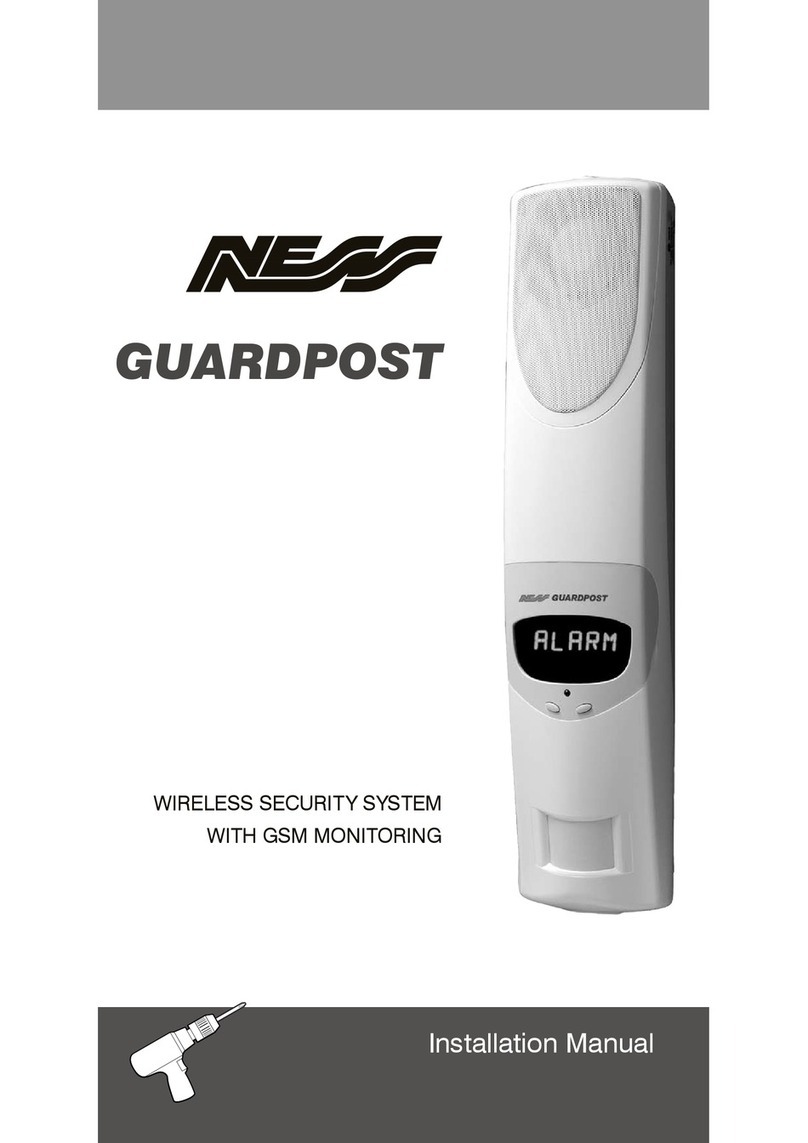
Ness
Ness Guardpost User manual
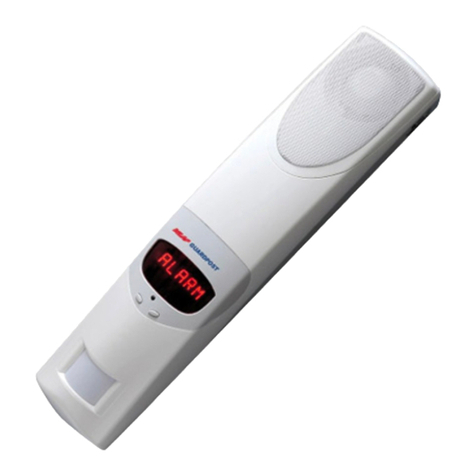
Ness
Ness Guardpost Assembly instructions

Ness
Ness LUX Quick start guide

Ness
Ness Guardpost User manual

Ness
Ness 5000 Series User manual
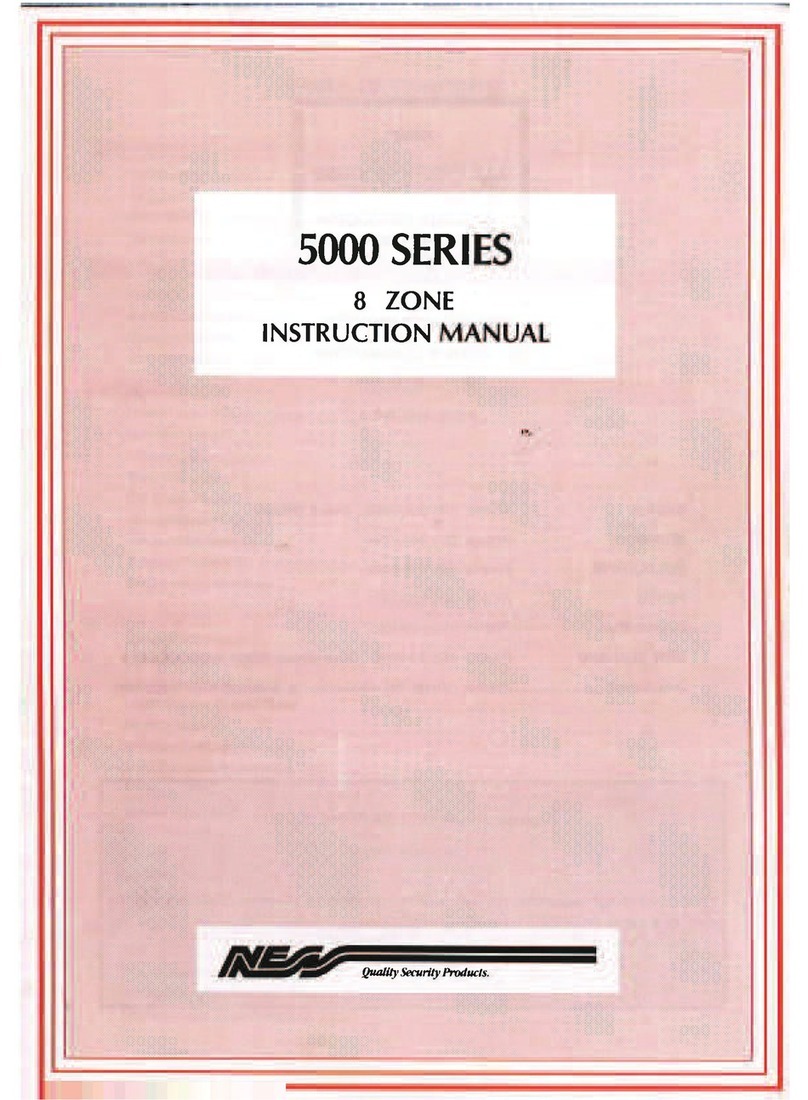
Ness
Ness 5000 Series User manual
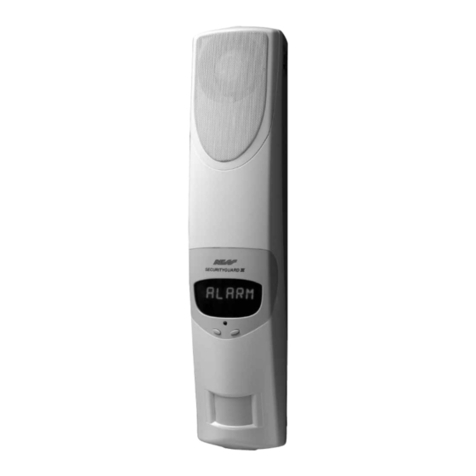
Ness
Ness SecurityGuard III User manual

Ness
Ness PRO-LD User manual
Popular Security System manuals by other brands
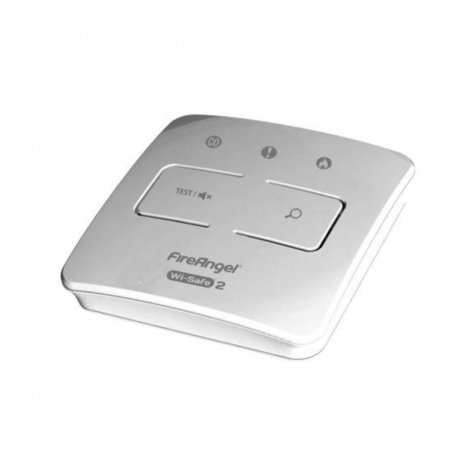
FireAngel
FireAngel Wi-Safe 2 P-LINE Series Installation & user guide
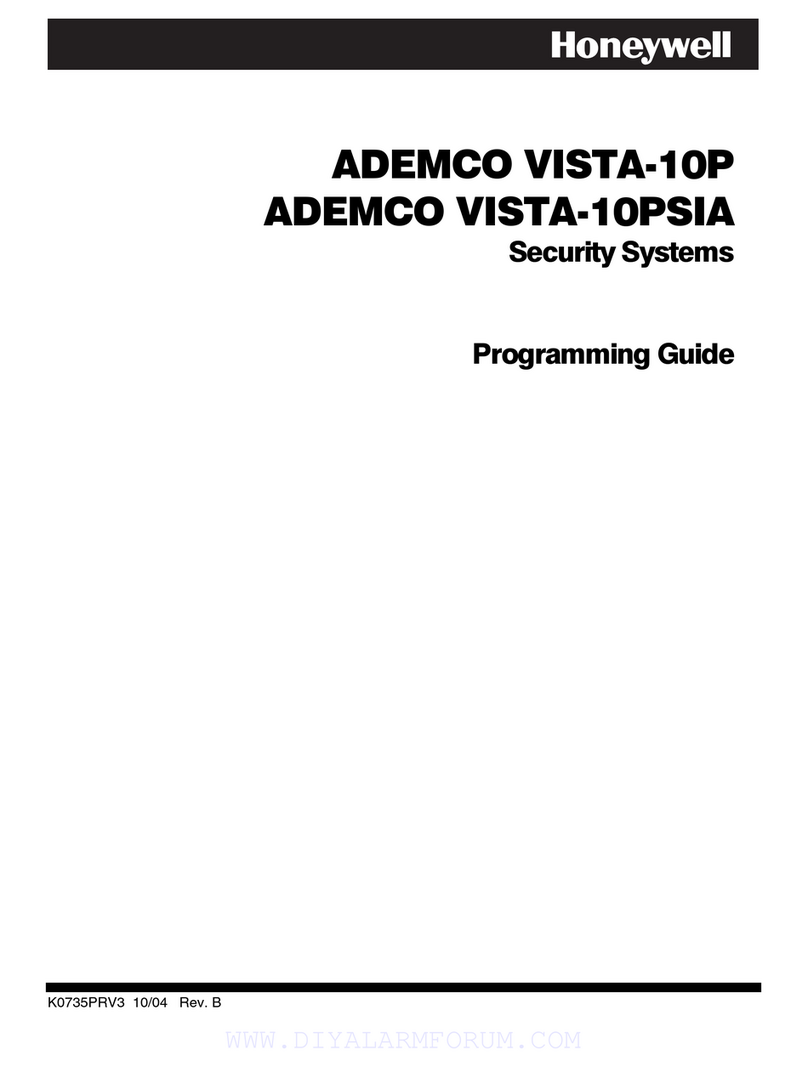
Honeywell
Honeywell ADEMCO VISTA-10P Programming guide
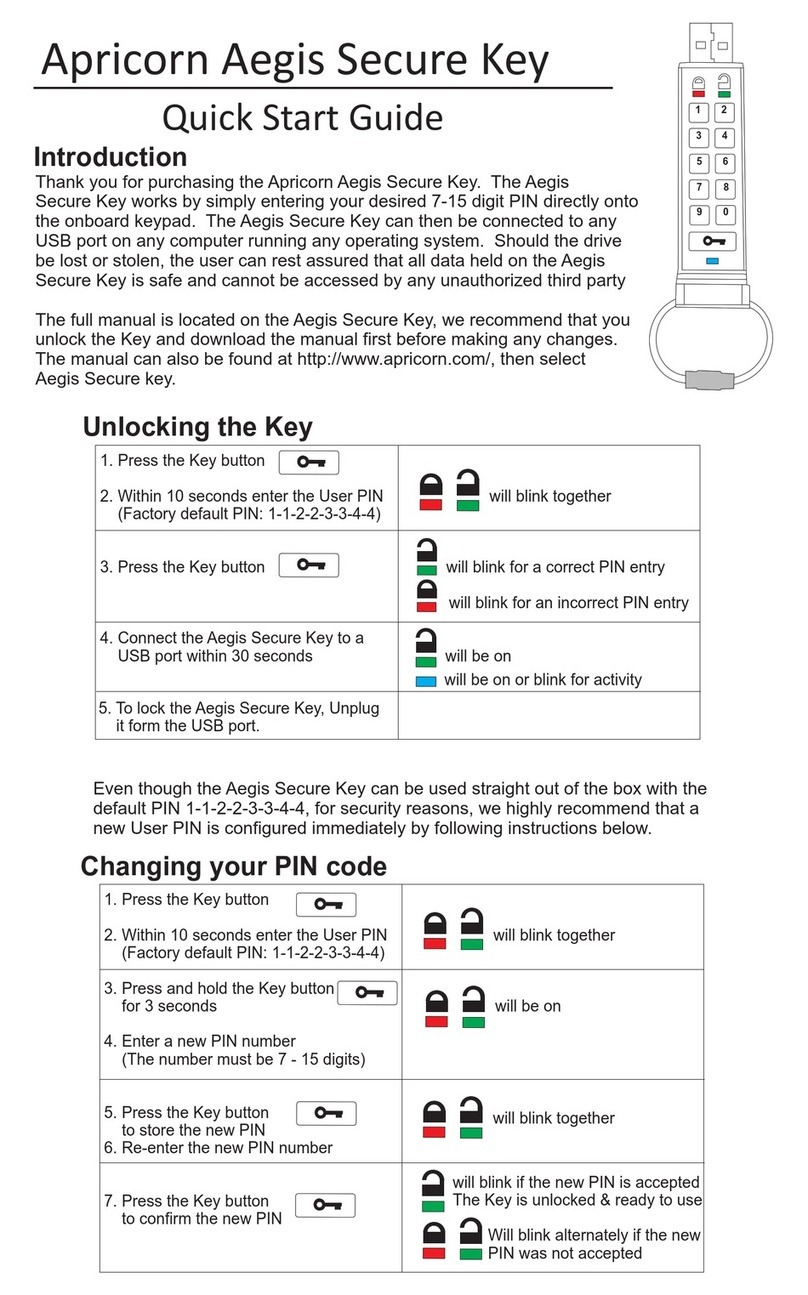
Apricorn
Apricorn Aegis Secure Key quick start guide
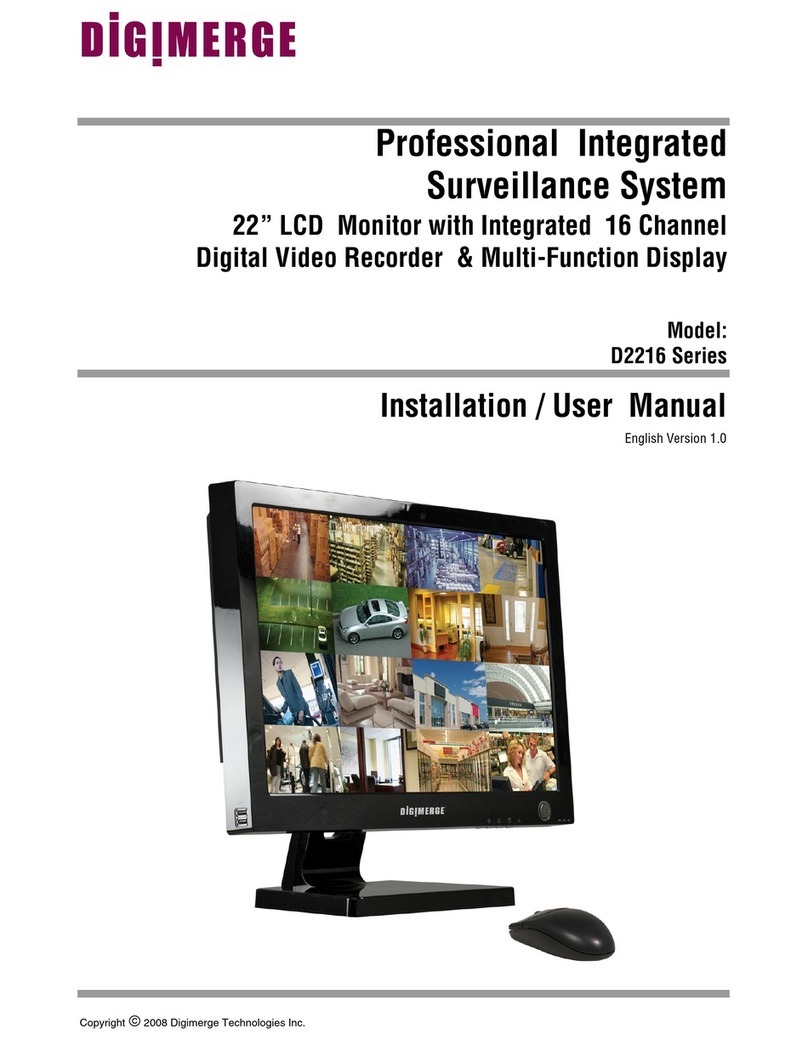
Digimerge
Digimerge D2216 Series Installation & user manual
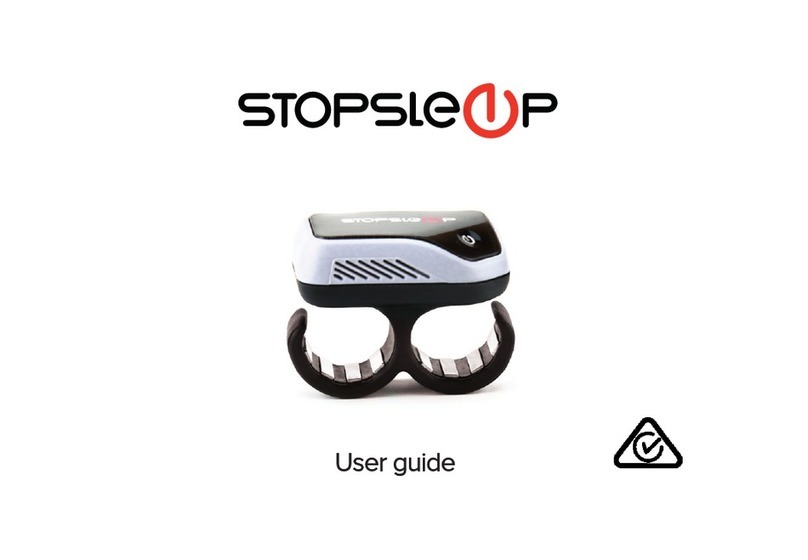
StopSleep
StopSleep StopSleep user guide
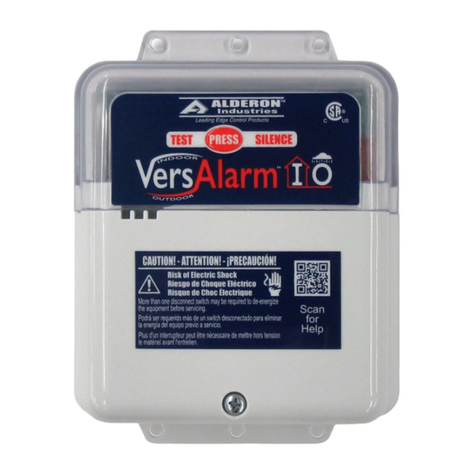
Alderon Industries
Alderon Industries VersAlarm I/O user guide



